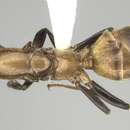mk
имиња во трошки


Extant: 1 valid subspecies
Azteca muelleri Emery, 1893l: 131, pl. 1, figs. 12-15 (s.w.q.) BRAZIL. Neotropic. AntCat AntWiki HOLTaxonomic history
Senior synonym of Azteca nigella: Wheeler, 1942 PDF: 236.Senior synonym of Azteca muelleri brunni: Longino, 1991a PDF: 1591.Senior synonym of Azteca ulei gibbifera: Longino, 1991a PDF: 1591.Senior synonym of Azteca muelleri janeirensis: Longino, 1991a PDF: 1591.Senior synonym of Azteca nigella: Longino, 1991a PDF: 1591.Senior synonym of Azteca muelleri nigridens: Longino, 1991a PDF: 1591.Senior synonym of Azteca muelleri wacketi: Longino, 1991a PDF: 1591.
Azteca muelleri is a species of ant in the genus Azteca. Described by the Italian entomologist Carlo Emery in 1893, the species is native to Central and South America.[2] It lives in colonies in the hollow trunk and branches of Cecropia trees. The specific name muelleri was given in honour of a German biologist Fritz Müller, who discovered that the small bodies at the petiole-bases of Cecropia are food bodies.
This ant is found in Central America and as far south as southern Brazil and eastern Peru, at altitudes of up to 1,800 m (6,000 ft). It occurs in rainforest and semi-deciduous forests where it is an obligate symbiont of Cecropia trees, often Cecropia glaziovii, Cecropia angustifolia,[1] or Cecropia pachystachya.[3]
Azteca muelleri forms a spongy nest in cavities inside the trunk and branches of a Cecropia tree. This is a mutualistic arrangement as the ants defend the tree against herbivorous animals while the ants benefit from food bodies provided by the tree.[4]
A. muelleri is very aggressive. Another insect that also lives in the hollow twigs and branches of C. pachystachya is the beetle Coelomera ruficornis. This beetle can co-exist on a single host tree with the ant Azteca alfari, but A. muelleri removes or drives away the beetles on its host tree, with larger colonies of A muelleri able to locate and expel the beetles faster than small colonies can.[3]
There is competition for resources between A. alfari and A. muelleri. Typically, A. alfari is the first to colonise a young Cecropia sapling, perhaps by the roadside or in a clearing, as these trees are pioneering species. As the young tree grows, A. alfari tends to occupy the tips of the branches and abandons the cavities in the larger branches; the colonies have multiple queens and a number of separate colonies come to occupy the same tree. In contrast, A. muelleri may colonise the tree at a later stage in its growth; it has a central nest in the trunk of the tree, where the brood is reared, but maintains passageways to the branch tips. The tree provides Müllerian bodies on the leaf stalks, which provide food for the ants.[5]
Azteca muelleri is a species of ant in the genus Azteca. Described by the Italian entomologist Carlo Emery in 1893, the species is native to Central and South America. It lives in colonies in the hollow trunk and branches of Cecropia trees. The specific name muelleri was given in honour of a German biologist Fritz Müller, who discovered that the small bodies at the petiole-bases of Cecropia are food bodies.
Azteca muelleri Emery, 1893 è una formica della sottofamiglia Dolichoderinae, endemica del Perù.[1]
A. muelleri contrae rapporti di simbiosi mutualistica con alcune piante mirmecofile del genere Cecropia (p.es. Cecropia pachystachya).[2]
La regina penetra, perforando lo sclerenchima esterno, nelle cavità cilindriche presenti negli internodi del fusto della pianta, vi depone le uova e fonda una colonia dando vita alla prima generazione di operaie. Queste ricavano il proprio nutrimento, e quello delle larve, raccogliendo attivamente dei corpuscoli glicolipidici (corpuscoli del Muller e pearl bodies), generati alla base delle foglie della pianta ospite.[3]
La colonia contribuisce allo sviluppo della pianta proteggendola dalle piante rampicanti e dagli insetti fitofagi.[4][5] In particolare risultano essere un efficace mezzo di difesa della pianta contro i coleotteri folivori della specie Coelomera ruficornis (Chrysomelidae), nei confronti dei quali hanno un comportamento estremamente aggressivo.[2]
Azteca muelleri Emery, 1893 è una formica della sottofamiglia Dolichoderinae, endemica del Perù.
Azteca muelleri is een mierensoort uit de onderfamilie van de Dolichoderinae.[1][2] De wetenschappelijke naam van de soort is voor het eerst geldig gepubliceerd in 1893 door Carlo Emery.
Bronnen, noten en/of referenties